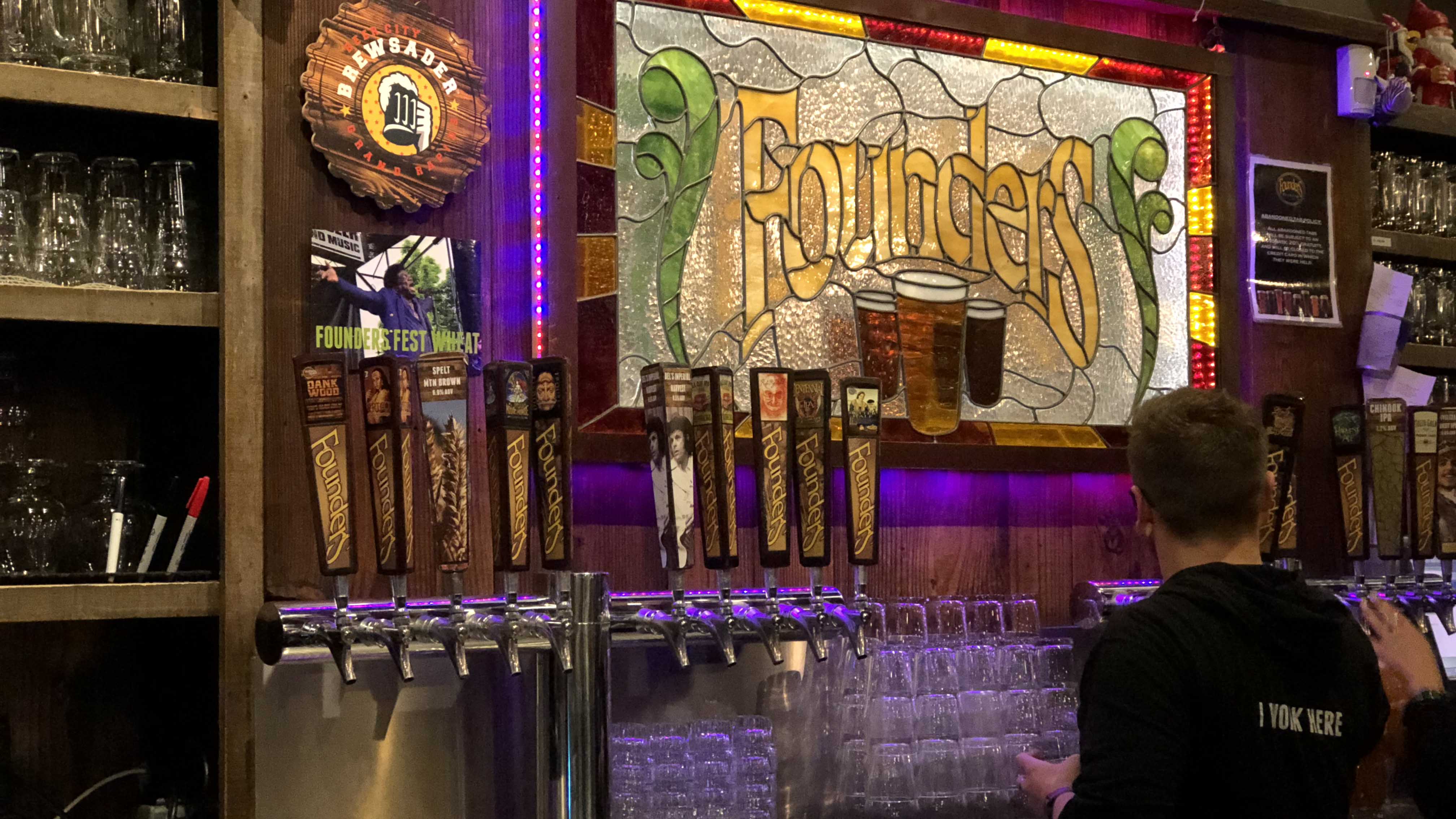The craft revolution has hit the United States. It’s disrupted a number of industries, catering to a new consumer who develops their preferences through different means, and according to a different set of values than their predecessors. The game of golf is beginning to experience the effects as evidenced by the popularity of gear companies like National Custom Works, Lie + Loft, Shapland Bags and Seamus Golf, as well as courses such as Sweetens Cove, The Mines and Winter Park 9. The new generation of golfers has a new set of ideals, and the industry is just beginning to adjust.
A brewing parallel
Walk into a local bar a little over a decade ago, and you would have been met with taps dominated by a familiar group of players – Bud, Miller, Coors and an import or two. The selection was homogenous across most bars, and consumers sadly saw the same beer everywhere they turned. The taste might vary slightly bar to bar depending on how clean the taps were, but the selection almost certainly did not.
Fast forward to today and these same bars offer a far different scene. Eclectic options from different breweries large and small are the norm. The best of the craft brewers are now regarded as must-drinks, and lead to drinkers making pilgrimages to find them. Craft brewers such as 3 Floyds, Founders and Alchemist have reached cult status and are known by almost every beer drinker in their respective regions. As a whole, the beer industry has become more specialized, consumer-friendly and personal than ever, and beer drinkers have rejoiced.

Founders Brewery
What caused this shift? One factor is certainly the internet, and the way in which it has made information readily available while allowing every person to embrace their inner nerd. It’s broken down long-standing barriers to entry into the beer business – enthusiasts become brewers, and brewers become entrepreneurs. Coupled with social media, the internet has amplified word of mouth, giving those entrepreneurs a better chance at success by extending their reach. The struggle that small breweries faced for decades, due to the high barrier of gaining exposure and educating consumers on their enhanced quality and taste, has now been greatly diminished. On social media, craft brewery fans can now serve as brand evangelists. In a matter of moments, loyal customers share their tastes and experiences, giving birth to a new form of marketing. The advantage now goes to the little guy who delivers the best product. Social media connected these breweries to their consumers in a more personal way than ever, and the positive impacts on the small businesses that deliver great products have been profound. The internet and social media have enabled a culture to explore, expand and understand their tastes at a more in-depth level than ever before. Society is shifting from a one-size-fits-all mentality to a right-size-for-me culture.
Golf and craft beer
Craft beer and golf course architecture have more parallels than you might think. Today, interest in golf courses and architecture is at an all-time high in America. The craft of golf course architecture and construction, and the resultant playing fields created, is the aspect of golf that makes it unique among all sports. Again looking at craft beer, we see waves of consumers traveling to obscure breweries across the country, just to get a taste of their unique batches. Each person has their own unique tastes and interests – some enjoy the light natured flavor of a Pilsner, others a hoppy IPA and some a full-bodied Porter – and they often go to great lengths to pursue those interests.
Applying the same lens to golf, barside debates amongst golf tragics often lead to a discussion of favorite golf courses, destinations and architects. In a way, the architects are the craft breweries and each of their courses is a small batch limited release craft beer. Every beer drinker has a favorite brewery and beer, and increasingly these days, every golf nut has a favorite architect and course. While there may only be a handful connoisseurs in either realm that understand all of the underpinnings of greatness in the craft, the consumers know what they like and want more of it.
Craft beer is defined as a beer made in a traditional or non-mechanized way by a small brewery. These beers have unique tastes and features, distinctly different from the mass-produced variety. Craft golf courses are courses that are unique in their style, aesthetic and features. These are the courses where the architect and associates labored over the process, creating a unique product. At its core, the principles of both a craft brewer and architect are consistent across each of their products. Quality ingredients, time and love are poured into them, each with their own unique details, flavors and features that set them apart from others in their portfolios.
What does it mean?
Golfers of the new generation have a keen interest in exploring and developing their taste by seeing unique architecture and courses. Breweries have proven that consumers aren’t afraid to travel to find these experiences, and the same trend is developing at select locations in golf.
Sweetens Cove Golf Club in South Pittsburg, Tennessee runs a golf course that is a 9-hole golf destination. That’s right, and despite having a trailer for a clubhouse, no food service and no on-site accommodations, 75% of Sweetens Cove’s rounds come from players who travel 75 miles or more to play. This business model would have been unfathomable a decade or even five years ago, but today it has proven to work. The Rob Collins design boasts a wildly unique design that thrills golfers and makes them want to loop the nine holes over and over. The course does not appeal to all players, but those who like it really love it.

The handcrafted and unique 7th green at Sweetens Cove
How has Sweetens survived? Social media and the internet. When The Fried Egg stumbled across this gem a few years back, it had 300 Twitter and Instagram followers, now it’s nearing 6,000 on each platform. By delivering a product that is wildly engaging to some golfers, the 9-hole course has created thousands of evangelists who spread the Sweetens Cove gospel to all of their followers. Sweetens Cove is kind of like 3 Floyds Dark Lord beer, which draws connoisseurs from all over the world to Muenster, Indiana to get a taste of their annual limited release batch.
Craft breweries go local
It’s important to note that golf is only reaching the tip of the iceberg with its new craft culture. It has infiltrated equipment, accessories and a handful of courses,but for it to achieve its full impact, a much wider audience must be reached. The popularity of craft beer exploded when breweries penetrated small communities around the country, guaranteeing access to consumers within a short drive. Right now, there are only a few dozen truly great golf courses that the public can explore. Most community courses are lousy bland versions of the game, and it typically takes much more than a short drive to find a “craft” gem.
Many suggest we are in the middle of the Second Golden Age. We strongly disagree because of this access issue. At present, the vast majority of great golf course architecture is largely unavailable to the public, unless they are in a position to expend large amounts of time and money. Most of the great American courses are still Golden Age privates or carry a high greens fee at a remote destination. The upstart golf resorts such as Bandon Dunes, Sand Valley and Streamsong are serving a wide range of hard-to-get craft beers from the game’s top brewers. These offer great opportunities for the public to go experience the new wave of architecture but remain exclusionary to most due to price. Sure, there are outliers and hidden gems around the country, but the majority of public golf courses are still serving a lukewarm Bud Light.
Thankfully, recent events show signs of change and a trend of great design coming to the masses at community courses. Riley Johns and Keith Rhebb’s Winter Park 9 has satisfied tens of thousands of golfers who got a taste of their unique, fun and bold brew. Houston’s Memorial Park just finalized plans on a Tom Doak redesign to their popular municipal course. Philadelphia’s Cobb’s Creek is set to restore its Hugh Wilson design with Gil Hanse. Cobbs is the rarest of craft brews, a municipal course designed by Hugh Wilson. Wilson enlisted help from the rest of the Philly School, a group of individuals who also collaborated on Wilson’s design of Merion and George Crump’s Pine Valley. These events along with a slew of others in the works point to golf being amidst a reawakening as quality craft offerings promise to finally reach the masses.
To make this the Second Golden Age, more public projects, be they new builds or redesigns of existing courses, need to turn to the craftsmen of golf course architecture. For every Winter Park, there remain at least ten cookie-cutter new public openings or redesigns. The current landscape of architecture has created a market imbalance on the supply side. There is a copious amount of eager young talent with not enough work. Rather than turning to an architect who has made a career of designing courses that taste like Bud Light, municipalities would be wise to take a page from Winter Park, a community that took a chance on two young architects who learned from golf’s best living craftsmen, and was rewarded with a course that is now beloved by players of all kinds. The good news for forward-looking communities is that where the craft beer and craft golf course architecture analogy falls apart is cost. While a small independent batch of beer costs more to the consumer, a course handcrafted by a young architect who does his or her own shaping work is less expensive.
It’s been nearly 30 years since the minimalism movement in golf course architecture started. With a new generation of golf architects waiting in the wings, a question of growing interest has become, what’s the next trend? To me, it’s clear: bringing handcrafted golf to communities across America to meet the demands of a new generation of golfers. These tragics and wanderlusts want distinct experiences that evoke thought. They are the same golfers making day-long treks to rural Tennessee to experience a nine-hole course with the boldest flavor available to the public, often dragging along friends who become converts. This next phase will require the reworking of defunct facilities by communities willing to make a commitment to the game.
A drinker who has grown accustomed to Coors Light will likely face sensory overload drinking their first mega-hops infused double-IPA. That’s okay. Ultimately, most woke up along with their taste buds in the new craft world to find themselves much more satisfied. While this new style of golf might initially shock the generation who grew up with formulaic and cookie cutter architecture, we are confident that they too will experience a reawakening of their joy of the game.
The original Golden Age brought great golf design across the country. The second Golden Age will make this great design accessible to the country. As municipalities and local public course owners understand this new consumer’s desire for a crafted golf experience, we will see a second Golden Age – a period when great design will become accessible to all, and each community will house a special craft playing field that they can call their own.


 by
by 
